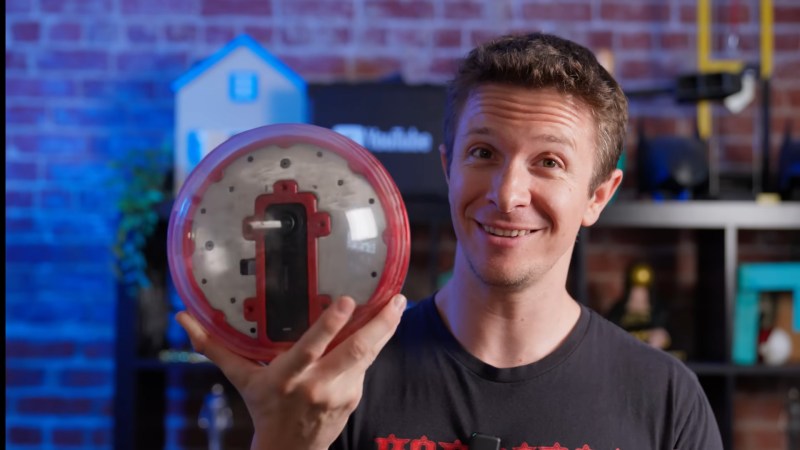If you are anything like us, last time you went bowling, you thought more about how the ball came back to you than actually knocking down the pin. Perhaps you even wondered what it would be like to be a bowling ball making its way back through mysterious and hidden machines. [Wren] and [Erik Beck] did as well, so they set out to make a bowling ball camera to find out.
At the heart of the contraption is an Insta360 X5 camera nestled between water-jet cut metal plates. Because each lens of the camera has a 200 degree field of view, anything in the overlap of the two lenses simply does not appear, so the two metal plates likewise, do not appear. This does leave a somewhat noticeable seam down the middle of the footage, but overall worked out very well. To prevent vibrations in the bowling ball, it can only be rolled along the plate line, making said seam appear in all the footage. Because the stabilization is happening purely digitally, and the camera itself is spinning with the ball, motion blur became an issue immediately. Fortunately increasing the shutter speed fixed the issue, along with an increase in ISO to compensate for the decreased exposure.
The outer shell was made of two acrylic or polycarbonate domes, with the former providing better optics, and the latter better strength. Unfortunately, clear half-domes can only be formed in certain sizes, and the closest to the standard bowling ball size of 8.5 inches was 8 inches. This led to many challenges come filming, resulting in neither the pin-side pickup nor the bowler side pickup being able to grip the ball. The pin side was solved using a simple foot, but the bowler side proved more challenging. After many attempts with cardboard shimming, the team finally just gave it a push with a regular sized bowling ball pushed in afterward.
The footage turned out brilliantly, and we would love to see a V2 of a correct diameter. Now, this is not the first time we have covered strange bowling engineering, make sure to read this piece on pins with strings next!
















Hmmm, “clear half-domes can only be formed in certain sizes” — so you’re saying that it is impossible to make a half-dome with a diameter of 8.5 inches?
They say in the video that their preferred manufactured only had the molds in specific sizes, hence the limitation.
“Because each lens of the camera has a 200 degree field of view, anything in the overlap of the two lenses simply does not appear”
That description confused me. The video says the same thing, and has a misleading diagram showing it too.
Things in the overlap of the lenses’ fields of view do appear. The “triangle of invisibility” is the area outside the FoV of both lenses, which exists due to the thickness of the camera body.
The diagram in the video obscures this by showing both FoVs centred on the same point, at the centre of the camera body. Instead they need to be moved outwards until the camera body isn’t obstructing the 200 degree sector of each.
maybe I’m getting too old, but I just don’t have the energy to watch a 30 minute video on how a couple of dudes put a camera inside a bowling ball.
some YouTubers take the “storytelling” thing too far and make the script a whole fantastic adventure in three acts. this guy did (but again, he works in Hollywood so that’s to be expected)
this combined with the over the top, effervescent personality of the presenter puts me off badly.
not saying that every video should be a boring university lecture but I wish they would dial down a few notches in presentation and focus more on substance.
sadly, the algorithm rewards long-form content, or under 2 minute shorts. remember when people were complaining youtubers stretched their videos to 10 minutes to qualify for more ads and extra revenue? well, those days are gone. YouTube now rewards long videos with high retention.
scroll to 29:30 to learn it failed, camera starts spinning inside the bowl half way down.
I guess you got confused by the post processing of the video. I’m quite sure they made the video rotate like that for artistic purposes
What? At 30:20 you see they’ve succeeded
It’s easy to say “just put the camera in the ball” it’s another thing to actually do it. We’re hackers and engineers, we care about planning, schematics, sourcing, making, assembling, trial and error. or else why would we be here? It’s important to document and know as much as possible so that if we ever do something, related or not, it might illuminate a dark place for someone else. If even one iota of the “fat” is useful to a maker? Then it all is.
Then don’t watch the video?
A rule of thumb that I have (and may or may not be applicable here) is if the video focuses more on the presenter than on the project it’s not going to be very good.
Of course there are exceptions but I think it works generally.
Good thing your energy was spent on writing a comment instead of just not watching the video.
This was done (probably simulated) in The Big Lebowski. The scene starts at 2:07:
https://www.youtube.com/watch?v=9G9kicC6pTU
Yes it’s mentioned in the video multiple times.
I skipped around at 1.5 speed and then still just gave up.
Some of these videos seriously make me wish youtube would go back to the old ten minute limit
Skip ahead to near the end. For some reason a lot of the video is about the ball return not working, which seemed a bit off topic to me. (Besides the obvious sameless shelf promotion)
Should put the camera in an independently rotating central assembly that keeps itself more or less stabilized while the outside rolls. Kind of like one of those droid balls, if I remember correctly.